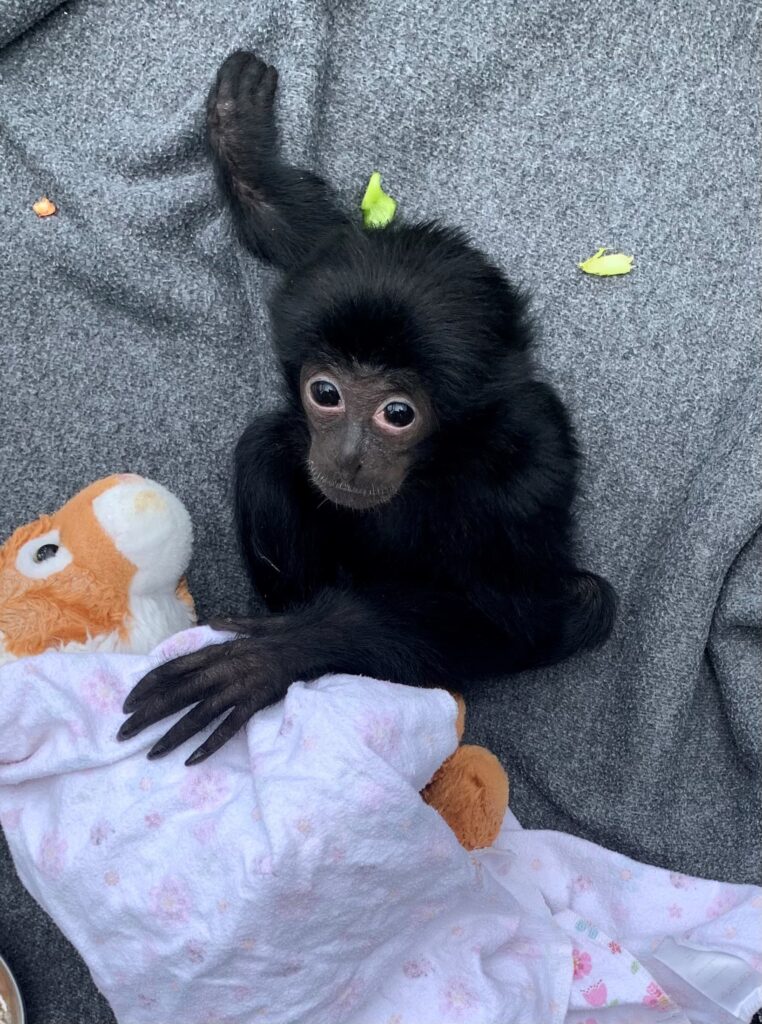Lovejoy’s Milestone Moments: Part One

Lovejoy, the Zoo’s juvenile siamang, was born to mother Malana and father Bali on June 26, 2022. As with all animals born at the zoo, keepers have kept a close eye on Lovejoy’s growth and development, especially once the trail construction project started in the fall.
Recently, keepers noted that Lovejoy appeared to be weaning from Malana earlier than expected and was displaying some possible developmental delays regarding the use of his limbs. Siamangs typically spend the first three to four months of their life in direct contact with mom while nursing, though they may continue nursing until about two years of age. Keepers and vet staff consulted with many species experts including the siamang Species Survival Plan (SSP) regarding their observations and became concerned that Lovejoy was not getting the quantity of nutrients his body required and was not meeting his developmental milestones. This can happen for many reasons in captivity, as there are so many aspects that contribute to infants hitting these milestones. Based on the consultations with these experts, the Zoo’s animal care team made the difficult decision to hand-rear Lovejoy until he gains the strength and becomes more independent.
Diet, sunlight and active socialization are critical components of healthy siamang development, so Lovejoy is receiving plenty of nutritional foods, formula, supplements, and a great deal of time spent outdoors and in close contact with staff. Lovejoy will be raised by our animal care staff much as he would by Bali and Malana. This includes holding and carrying him for much of the day as parental bonding and touch are very important for juvenile siamangs. Because of this, you may see Lovejoy being cared for by our animal care team at the Animal Wellness Campus as they go about their regular duties. Staff will also gradually encourage LoveJoy to grow in his independence, as he would at this stage with his parents. He has a big enclosure with ropes, baskets, and hammocks at multiple levels to encourage building strength through climbing and exploring.
As he grows in strength and hits his milestones, the Virginia Zoo team will continue to consult with species experts to determine when he may be ready to return to the habitat with Bali and Malana. The Virginia Zoo veterinary team is optimistic that though Lovejoy will require routine veterinary monitoring, he will have a good prognosis and will very likely have a normal life.
As you visit the Animal Wellness Campus, you may see Lovejoy holding onto our staff (or being swaddled/carried by our staff). While primates are very cute, they are also endangered and can be very dangerous when handling, making them unsuitable pets. Siamangs are endangered. Their numbers have declined by 50 percent over the last 40 years, primarily because of the illegal pet trade and habitat loss. Many adults are killed illegally so that their young can be sold as pets.
The decision to hand-rear Lovejoy was not made lightly. Our staff consulted experts and weighed all options before making that decision. Ultimately, it was determined that Lovejoy could not receive the nutrients that he required staying in his habitat with Bali and Malana. He would not have survived without intervention. Our goal is to provide Lovejoy with the treatment he requires to gain strength and recover. Attentive veterinary care, carefully curated enrichment opportunities, and training with several species allows staff the opportunity to build pathways for communication that ensure we are meeting the needs of each individual.
What does the Virginia Zoo do to help with siamang conservation?
The Virginia Zoo supports the Association of Zoos and Aquarium’s Ape Taxon Advisory Group (often referred to as Ape TAG). The Ape TAG supports conservation initiatives such as anti-poaching patrols and law enforcement, improved management area and support of sanctuaries, and increased community involvement to help protect apes. One of the biggest threats to siamangs and many other apes in Indonesia and southeast Asia is unsustainable habitat loss from either timber producers or agriculture (particularly palm oil). The Roundtable on Sustainable Palm Oil (RSPO) was created to address these concerns and has developed a set of environmental and social criteria that companies must meet to produce RSPO Certified Sustainable Palm Oil.
You can make a difference by downloading the PalmOil Scan App and ensuring you buy products that either do not contain palm oil or are made with sustainably produced palm oil.